
We live in a spiral galaxy. Our Solar System resides about three quarters of the way out from the centre of our Galaxy, or "Milky Way", in a spiral arm consisting of gas and young stars. However, galaxies exist in several different forms. Elliptical galaxies are large, round, aggregates of predominantly old stars. Spirals, like our Galaxy, possess disks with catherine wheel-like arms that are the sites of ongoing star formation.

Irregular galaxies, as their name implies, lack a well defined structure, but usually possess numerous star formation regions and large amounts of gas and interstellar dust (micron sized particles made up of carbon and silicon). Galaxies inhabit variously populated regions of space. The low density regions are well populated by spiral and irregular galaxies, whilst the denser, rich clusters are dominated by elliptical galaxies.

It has become clear over the last 30 years that extremely dense objects exist both in our Galaxy and in the centres of many nearby galaxies. In our Galaxy (and most likely others) small regions of space weighing more than about 5 of our Suns exist. They consume nearby gas and stars and nothing ever escapes their grasp. In the centres of large galaxies similar regions of space exist that also consume stars and gas. However these regions can weigh as much as several billion (1 billion = 1,000,000,000 or 109) Suns.
This web site will describe the theory and observations of these black holes and recent observations of the centres of galaxies that are providing new ideas about galaxy structure and evolution. The galaxies with these exotic, extremely massive objects at their centres may well be called "Hearts of Darkness".
Shine a torch upwards in the night sky. The light travels along a straight line then eventually fades, scattered by dust particles in the air. Travelling at 300,000 kilometres per second light is not hindered by the gravitational field of the Earth that requires an object to travel at least 11 kilometres per second to escape its influence. What mass would Earth need to be to stop the torch light from escaping? Based on Newton's gravitational laws the Earth would need a mass equivalent to 2100 times that of our Sun. Such a massive Earth would not be a very hospitable place to live! The intense gravitational field would crush pre-existing structures. If however we used the existing mass of Earth and could squeeze Earth into a sphere slightly smaller than a golf ball, again, light would not escape from its surface.
Theorists from the late 1930s onward predicted that small sized stellar objects could exist as the final products of stellar evolution. A "star" with a radius of 5 kilometres would need to weigh about 1.7 times the mass of the Sun to stop light escaping from its surface. Did such "dark" stars exist?

The partial answer to this question was the discovery in 1967 of radio pulses that came from rotating neutron stars, or pulsars. Pulsars are extremely small, massive stars made of tightly packed neutrons. They are formed during a supernova explosion which occurs to high mass stars. Since their discovery, over one thousand pulsars in the Galaxy have been discovered. A New Zealand astronomer, Richard Manchester, who works at the Australian Telescope National Facility, is one of the worlds leading researchers of pulsars. Whilst neutron stars or pulsars are extremely massive and small, their largest escape velocity is still only about 80% of the speed of light. So they are close to being dark stars, but not quite!
| People have been thinking about "dark stars" for over two centuries! In 1783 the Reverend John Michell delivered a paper to the Royal Society in London announcing that invisible stars may exist if they were massive enough. The Frenchman Pierre Laplace discussed a similar phenomenon several years later. Early this century the German astronomer Karl Schwarzschild succeeded in finding solutions to some outstanding problems in Einstein's theory of General Relativity, which describes gravity. Some solutions of Einstein's equations become infinite (called a singularity) at zero radius. Schwarzschild calculated that a singularity, could exist at a small radius for a very dense object. For the Sun this radius would be 3 kilometres. We know this radius nowadays as the Schwarzschild (or gravitational) radius, and it is that required by an object so that radiation cannot escape from it. In 1933 astronomers Walter Baade and Fritz Zwicky suggested that the remnant of a supernova explosion could be a very dense star composed of neutrons. |
|---|

In 1939 Robert Oppenheimer and colleagues used quantum theory to determine that stable neutron stars could exist, and then went further, publishing a paper that would become a classic. It described massive stars that, once finished thermonuclear burning, would collapse forever. A physical model for a "dark star" had been found!
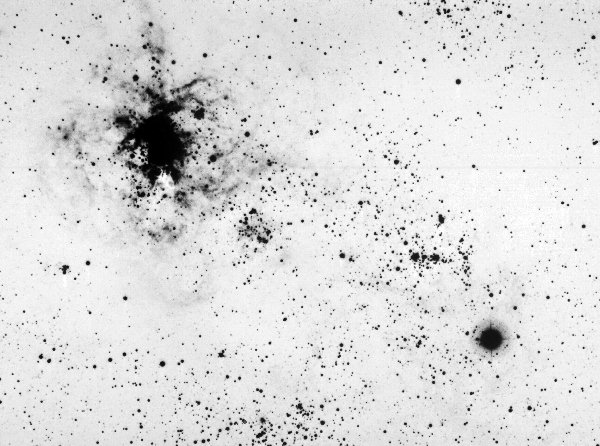
| Let's stop for a moment. A problem is looming! How would you detect an object whose gravitational field is so great that all radiation (light emitted from a torch is just one type of radiation) cannot escape from it? The answer is that you cannot observe it directly, but possibly indirectly, by observing its effect on surrounding objects. |
|---|
As it turns out, any star greater than 3 solar masses must eventually form such a "dark star" after thermonuclear reactions have ceased, since no known source of pressure can support it. These objects are called "black holes" and this term was first coined by the physicist John Wheeler.
In 1963 a New Zealand mathematician, Roy Kerr, then working at the University of Texas, found solutions to the general relativistic field equations for the case of a rotating star. Since stars rotate, black holes should rotate, and these solutions were critical in understanding the space-time effects of spinning black holes. A major breakthrough had been made. Kerrs solutions showed that as well as having an event horizon (at the gravitational radius) a spinning black hole had another important horizon, at a greater radius than the event horizon, called the static limit. The region between the event horizon and the static limit is called the ergosphere. Later studies by Penrose, Wheeler, Bekenstein and Hawking amazingly showed that black holes could emit radiation from the ergosphere. In general, the smaller a black hole, the larger the amount of radiation could be emitted. However, even for stellar mass black holes the rate of radiation is very small, so that they exist for hundreds of billions of years.
So, are there any black hole candidates? Yes, there exists strong, indirect, evidence for many. One observational signature is the rapid variation of high energy X-rays from an object. This variation can be caused by a binary star system that consists of a black hole orbiting a very large (supergiant) star. Gas from the supergiant is gravitationally attracted to the black hole and as the gas approaches it heats up to 1 million degrees and emits high energy X-rays. A decrease in the strength of X-rays from the binary system is explained when the black hole goes behind the supergiant during its orbit. Many such binary systems are known. One system, Cygnus X-1, in the northern sky constellation Cygnus, is one of the best candidates for a black hole.

Another strong candidate for a black hole is LMC X-1. LMC stands for Large Magellanic Cloud, a close neighbour galaxy to our Galaxy. LMC X-1 is the strongest source of X-rays in the LMC and it originates from an unusually energetic binary star system. This source is thought to be a normal and compact star orbiting each other, similar to the Cygnus X-1 system. The X-rays shining from the system knock electrons off atoms, causing some atoms to glow noticeably in X-rays. Motion in the binary system indicates the compact star is probably a black hole, since its high mass - roughly five times that of our Sun - should be massive enough to cause even a neutron star to collapse.
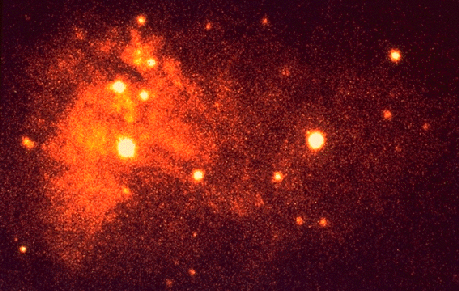
Many galaxies possess nuclei that emit vast amounts of radiation. The amounts can vary from a small fraction to several thousand times greater than the radiation output of an entire normal host galaxy. In the 1950s and 1960s radio astronomy provided important clues to the nature of such galaxies. Powerful radio sources in the sky were found to be associated with faint elliptical galaxies. Many showed dual lobes of radio emission on opposite sides of the optical galaxy. The radio emission was caused by radiation from high velocity, spiralling electrons in strong magnetic fields. This radiation is called synchrotron radiation. It was quickly realised that the majority of the radiation from such galaxies (called active) was not from stellar sources, but due to this type of high velocity particle emission.
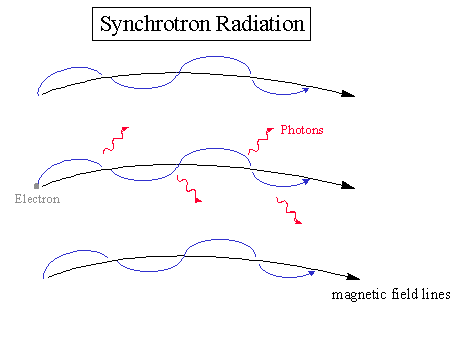
Some clues indicated the probable extreme power source of activity in galaxies. The radio lobes observed on either side of the optical galaxy were sometimes connected to a small, emission region in the nucleus of the galaxy via narrow, straight jets. Energy arguments suggested that the lobes of emission had to be continually replenished by fast moving electrons. The presence of jets joining the nucleus to the lobes suggested that something in the small nucleus was the energy source. Variability in the optical and radio emission of the nucleus on time scales of hours also suggested a very small energy producing region (of light hours diameter, similar in size to the Solar System).
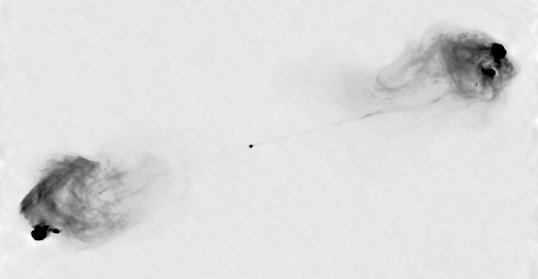
Cygnus A: An image obtained with the Very Large Array (VLA) radio telescope in New Mexico at a wavelength of 6 centimetres. Note the bright lobes, and narrow jets that point back to the nucleus. The optical galaxy lies well within the radio lobes, centred on the radio nucleus.
It is now generally believed that such activity in galaxies is powered by supermassive objects in their nuclei.
The presence of supermassive objects in galaxy centres was first inferred in the late 1970s. Imaging and spectral observations of the nucleus of the large elliptical galaxy in the Virgo cluster of galaxies, Messier 87 (or M87, see image above), by Peter Young and Wallace Sargent and collaborators, suggested the existence of a compact object of 5 billion solar masses within 300 light years of the nucleus. This amount of mass is difficult to explain by normal populations of stars, and many astronomers were convinced that supermassive black holes (SBHs) easily explained the observations.
Further, the very small size and enormous energy outputs of these nuclear regions strongly suggest black hole accretion (mass converted to energy by the extreme gravitational field of the black hole) as the energy source. Rapid progress has been made recently in the study of central regions of galaxies by using the high resolution capabilities of the Hubble Space Telescope (HST) and radio telescopes on Earth. HST is in orbit around the Earth, and is above the atmosphere that blurs ground-based optical telescope images.
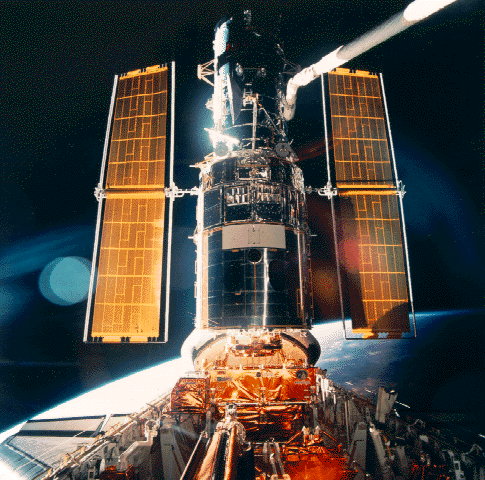
It is now apparent that many features of active galaxies are common. A model has been put forward that tries to reconcile the differing properties of activity by assuming that the physical structure in the nucleus of all active galaxies is similar. The "unified model" assumes that all active galaxies possess a SBH surrounded by dust in the shape of a torus (doughnut-like). Relativistic jets (ie. radio jets) if detected will appear at right angles to the major axis of the torus.
Variations to the model include the evolutionary status of the SBH (eg. its mass, possible spin), the type of host galaxy (ie. spiral or elliptical), the accretion rate of fuel (ie. gas, stars) into the nuclear (accretion disk + SBH) region, and importantly, the aspect or orientation of the torus to our line of sight. Such model variations go a long way to explain the variety of physical properties seen in active galaxies.
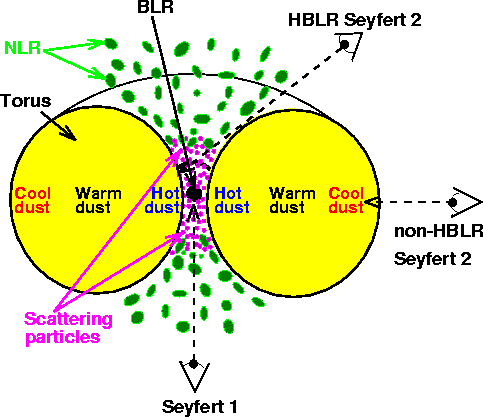
By looking along a line of sight into the hole of the torus, we see the highest velocity gas clouds, nearest to the SBH. Such galaxies are classified as Seyfert 1, Quasar and Blazar. If the torus obstructs our direct view, we can only observe lower velocity gas clouds, further from the SBH, and possibly scattered light from the nuclear region, and we then detect active galaxies of the Seyfert 2 and radio galaxy types. In rough order of increasing luminosity the active galaxies are Seyferts, Radio Galaxies, Blazars and Quasars. It is now thought that the host galaxies of Seyferts are spirals, and elliptical galaxies host radio galaxies and quasars although there could be some overlap. Also, many distant quasars imaged by HST show peculiar structures that are indicative of interacting or merging galaxies, suggesting that collisions between galaxies may help to produce the high luminosity quasars.

NGC 4261 - A large, dusty disk
NGC 4261 is a bright elliptical galaxy. It has radio jets extending well outside the optical galaxy. The HST image shows a large, about 400 light years in diameter, dusty disk slightly inclined to our line of sight. Note that the radio jets are aligned perpendicularly to the major axis of the dusty disk (ie. the extended cool region of a torus) consistent with the unified model. HST spectral observations of gas in the nucleus suggest a 5 x 108 solar mass SBH.
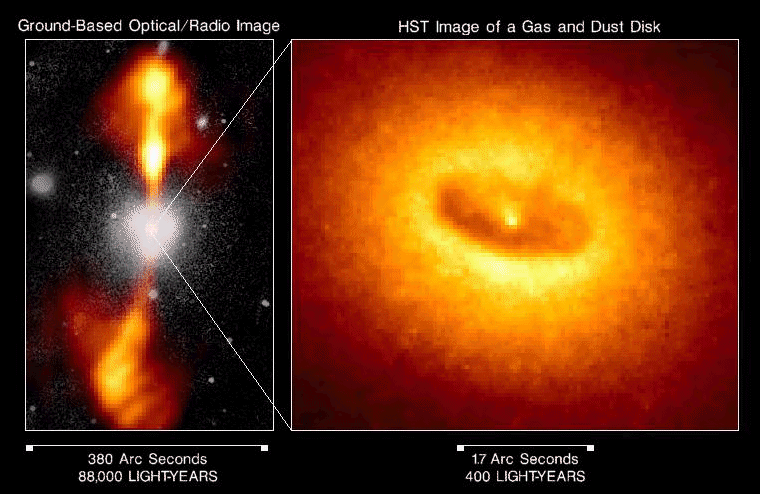
| A word of warning. Even though HST allows us the clearest optical view of galaxy centres, we do not directly resolve the SBHs or their gaseous accretion disks. For example, NGC 4261 is approximately 82 million light years distant, and at that distance, an SBH accretion disk of 1 light week diameter would span about 1/1000 the size of a HST imaging pixel element. What we do see in HST images however are the cooler, dusty disks surrounding the SBH and hot accretion disk. However, the resolving power of HST does allow important velocity measurements at small distances from the nucleus, which constrains the mass contained within that distance. |
|---|
Messier 87 - revisited
M87 is one of the nearest ellipticals that shows signs of activity. As long ago as 1918 H. D. Curtis discovered an optical "jet" originating from the nucleus. The optical emission from the jet is also synchrotron radiation, seen usually as radio emission. The synchrotron jet occurs at optical wavelengths when the fast moving electrons are very energetic. M87 is a powerful radio source (known as 3C 274 and Virgo A) and the radio source at the nucleus is compact, spanning a diameter of less than 3 light-months.
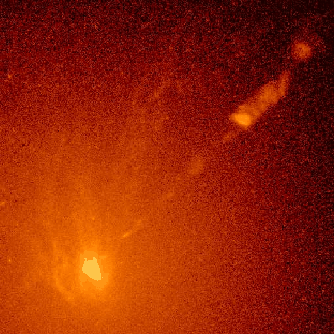
M87 as observed by HST showing the nuclear gas disk (lower left) and jet.
HST detects a small disk of gas in the nucleus. The disk is approximately elliptical in shape, and its minor axis is close to the direction of the optical synchrotron jet. Radial velocity measurements along the gas disk shows high recession and approach velocities of 500 kilometres per second. A central mass of 2 billion solar masses is deduced. The authors conclude that the disk of gas is feeding a SBH in the nucleus, consistent with (but smaller than, by a factor of about two) the mass inferred from the measurements in the 1970s mentioned previously.
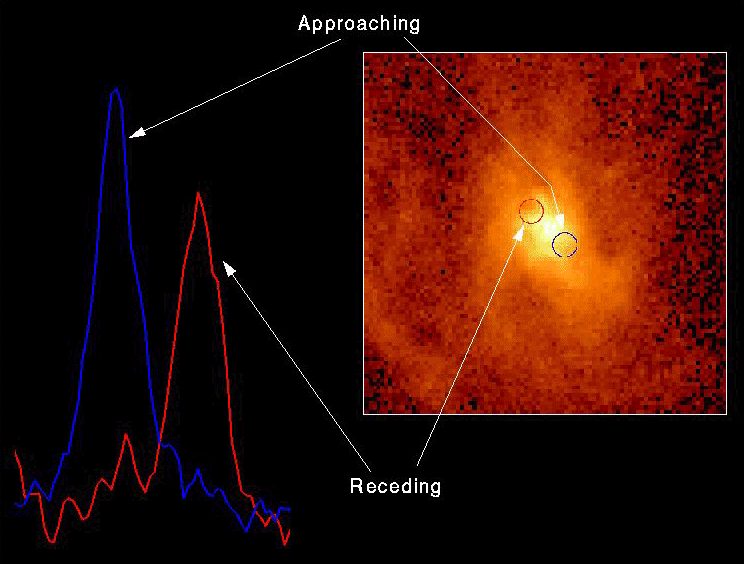
For a number of years evidence has been growing that the centre of our Galaxy may harbour a SBH. The motions of stars around our Galaxy centre indicate increased velocities down to very small distances, about 10 light days. The density of matter needed to explain such motions rules out most alternatives to a SBH.
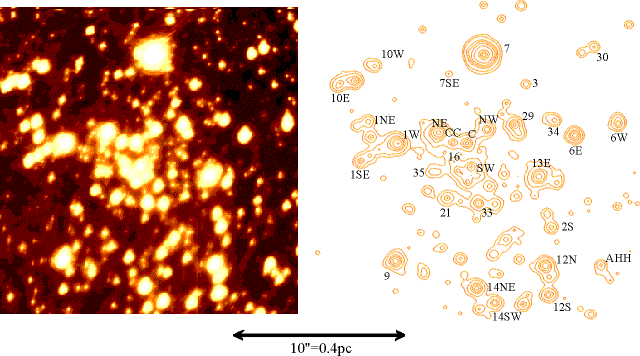
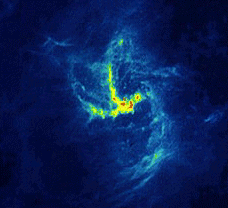
As in the case of stellar mass black hole systems, we may expect to detect large amounts of X-rays from an accretion disk around a Galactic Centre SBH. However, observations have resolved most of the X-ray emission in the region to a handful of unrelated X-ray binary systems. The X-ray luminosity of the Galactic Centre is some 7 orders of magnitude lower than expected for an accretion disk around a 3 million solar mass SBH. It is therefore possible that if a SBH does reside in the centre of our Galaxy, it is dormant.
The picture that has emerged is as follows. SBHs are probably a normal feature of the central regions of bright galaxies that have spheroidal components (eg. elliptical galaxies, spiral galaxies with a bulges). SBHs have not been detected in irregular galaxies. The SBH masses scale roughly with the mass of the host galaxy, implying a strong link between the growth of the galaxy as a whole, and the growth of the SBH.
Some fundamental questions remain however. What is the link between SBHs seen today in relatively nearby and lower luminosity galaxies to distant, very luminous quasars? Quasars were more populous in the early universe, and so it is possible that many nearby galaxies were quasars in their youth, and now harbour relic SBHs that earlier emitted high (quasar) luminosities. How do SBHs evolve? We also believe that galaxy mergers were more prevalent at earlier times in the Universe. What part then do galaxy mergers play in SBH evolution? How would two pre-existing SBHs behave if their host galaxies merged? Such events may not be observable by the usual optical, radio or X-ray telescopes, but by the detection of gravitational waves. A merger of two 107 solar mass SBHs would radiate energy at a frequency of about 10-4 Hz.
The European Space Agency (ESA) is planning a space-based gravity wave detector, called Laser Interferometric Space Array (LISA). The primary objective of the LISA mission is to detect and observe gravitational waves from massive black holes and galactic binary stars in the frequency range 10-4 to 10-1 Hz. Useful measurements in this frequency range cannot be made on the ground because of the unshieldable background of local gravitational noise. From recent research and upcoming missions like LISA we are finally shining some light on these enigmatic hearts of darkness.
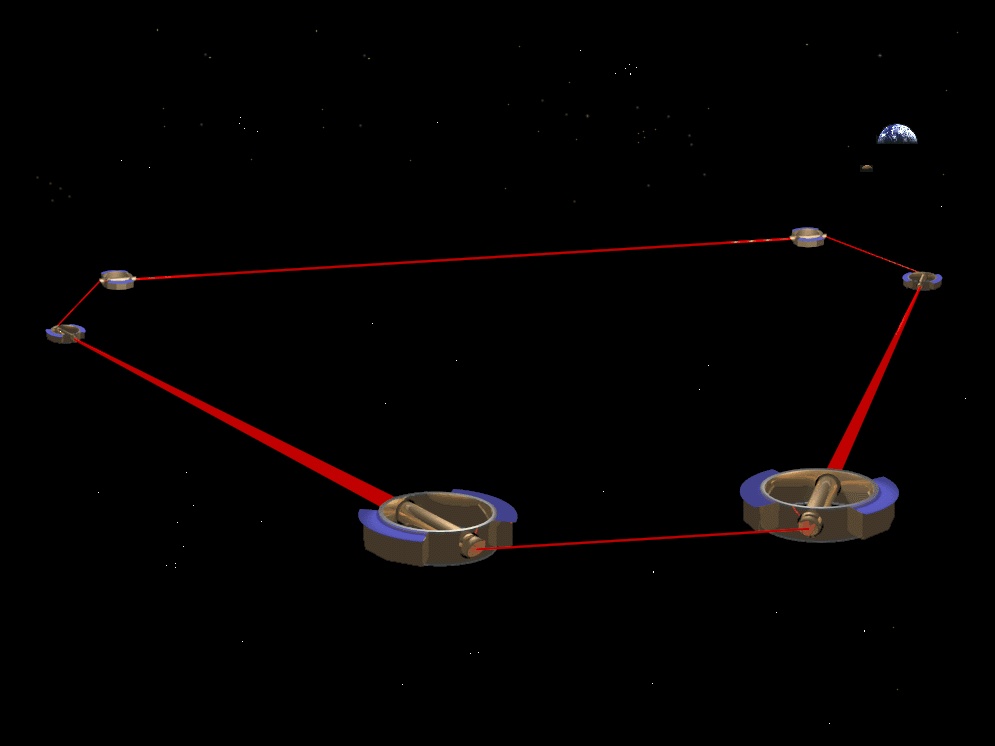
www.stsci.edu (Space Telescope Science Institute)
www.nrao.edu/doc/vla/html/VLAhome.shtml (Very Large Array)
www.rsnz.govt.nz/ctees/astrospace/ (Royal Society of New Zealand Standing Committee on Astronomical Sciences)
www.seds.org (Students for the Exploration and Development of Space)
www.carterobs.ac.nz (Carter Observatory, The National Observatory of New Zealand)
www.phys.canterbury.ac.nz/research/astronomy/astronomy.html (University of Canterbury - Department of Physics and Astronomy)
Sky and Telescope, Sky and Space, Astronomy magazines.
Gribbin, J. 1998, In Search of the Edge of Time, (Penguin: London).
Disney, M. 1998, A New Look at Quasars, Scientific American, June 1998, p36.
Thorne, K. 1995, Black Holes and Time Warps, (Norton: New York).
Professor John Hearnshaw and Assoc. Prof. Peter Cottrell of the University of Canterbury and Dr Ian Bond of the University of Auckland provided comments on an initial draft of this document.
The DIRBE near-IR image is credited to the NASA COBE project. Alan Gilmore kindly provided the print of SN 1987A taken by him at Mount John University Observatory. The X-ray image of LMC X-1 was taken by the ROSAT, a joint German-U.S.-U.K. project. HST is a cooperative program of ESA and NASA. Images were obtained from the Space Telescope Science Institute (STScI; www.stsci.edu) and Office of Public Outreach (oposite.stsci.edu) web sites. Chris Carilli donated the VLA image of Cygnus A (Perley, R.A., Dreher, J.W. and Cowan, J.J. 1984, Astrophysical Journal Letters, 285, L35). Charlene Heisler gave permission to reproduce the schematic diagram of a Seyfert galaxy (Heisler, C.A. Publications of the Astronomical Society of Australia, 1998, 15,2,167 and http://www.atnf.csiro.au/pasa/15_2/). The near-IR image and contour map of the Galactic Center was taken by the Galactic Center Research Group at the Max-Planck-Institut für extraterrestrische Physik using the SHARP I camera on the New Technology Telescope at ESO. The VLA 6cm image of the Galactic Centre is courtesy of Prof. K.Y. Lo, University of Illinois, Urbana-Champaign, Dept. of Astronomy.
antwrp.gsfc.nasa.gov/apod/ap950908.html
ftp.seds.org/pub/images/space_art/event04.jpg
antwrp.gsfc.nasa.gov/apod/ap951230.html
ftp.seds.org/pub/images/hubble/wfpcin03.gif
oposite.stsci.edu/pubinfo/pr/97/28/c.html
oposite.stsci.edu/pubinfo/jpeg/ngc4261.jpg
oposite.stsci.edu/pubinfo/pr/94/23.html
oposite.stsci.edu/pubinfo/gif/M87Plot.gif
www.mpe-garching.mpg.de/www-ir/GC/gc.html
therin.ncsa.uiuc.edu/Cyberia/Bima/GalCntr.html#sgr.west.6
www.estec.esa.nl/spdwww/future/html/lisa.html
COBE - Cosmic Background Explorer
DIRBE - Diffuse Infrared Background Experiment
ESA - European Space Agency
ESO - European Southern Observatory
HST - Hubble Space Telescope
LISA - Laser Interferometric Space Array
LMC - Large Magellanic Cloud
NASA - National Aeronautical and Space Agency
NGC - New General Catalogue
NTT - New Technology Telescope
ROSAT - Röntgensatellit
SBH - Supermassive black hole
VLA - Very Large Array
Accretion Disk - A disk of matter, usually gas, in orbit around an object. In a binary star system gas can be transferred between the stars causing a disk of gas to form around one star that in some circumstances, is heated to several million degrees and emits X-ray emission.
Black Hole - A region of space in which the gravitational field is so strong, neither radiation nor matter can escape. black holes are thought to form after a star (greater than or equal to 3 solar masses) undergoes gravitational collapse. If the star mass is between 1.4 and 3 solar masses the collapsed remnant will be a neutron star. A star equal to or less massive than 1.4 solar masses will collapse to a white dwarf star.
Gravitational Waves - A major disturbance to a gravitational field will produce gravitational waves. These waves, that travel at the speed of light, are predicted by Einstein's General Theory of Relativity. Gravitational radiation is emitted most strongly in regions of space where gravity is intense (eg. collapsing stellar cores, neutron stars, black holes).
Hz - The unit of frequency, Hertz. Given in cycles (or number of waves) per second.
Neutron Star - A small, very dense star comprised primarily of neutrons. During a supernova explosion the core of the progenitor star compresses so that protons and electrons merge into neutrons. Their diameters can be about 20 kilometres with incredible densities around 1015 grams per cubic centimetre. Rapidly spinning neutron stars are called pulsars.
Quantum Theory - A theory developed early this century that describes matter as displaying particle and wave-like properties.
Singularity - A singularity occurs when the solution of equations in the General Theory of Relativity becomes infinite. This frequently occurs at a radius of zero, but in the case of Einstein's theory of gravity, a singularity can also occur near a very massive object at a very small, finite radius.
Supermassive black hole (SBH) - A black hole that occurs at the centre of a galaxy. It is uncertain how they form, though their general physical properties are probably similar to black holes formed from the collapse of a single, massive star. Supermassive black holes can have masses as large as several billion solar masses.
Supernova - An explosion of a star. Supernovae can be classified into two main categories. Type I do not have hydrogen lines in their spectra, occur in all galaxy types, and are thought to occur when the white dwarf of a binary star system explodes. Gas transfer from the companion star to the white dwarf increases its mass above 1.4 solar masses and it explodes. Type II have hydrogen lines in their spectra and occur in all galaxies except ellipticals. They are thought to occur when a star of about 8 solar masses finishes thermonuclear burning.
Thermonuclear Burning - The process in which new elements are formed in stars by nuclear reactions. Energy is released when lower atomic weight atoms fuse to form heavier atoms. These reactions only occur because the temperature in the core of the star is sufficiently large (about 107 degrees) to give the particles high velocities so they can interact.
White Dwarf - A star in an advanced stage of stellar evolution. A star, 1.4 solar masses or smaller, exhausts its sources of thermonuclear energy, and collapses under its own gravity. The matter is compressed into a very dense state. A well known white dwarf star is Sirius B, that has a mass similar to our Sun, but a diameter about 5 times larger than Earth.